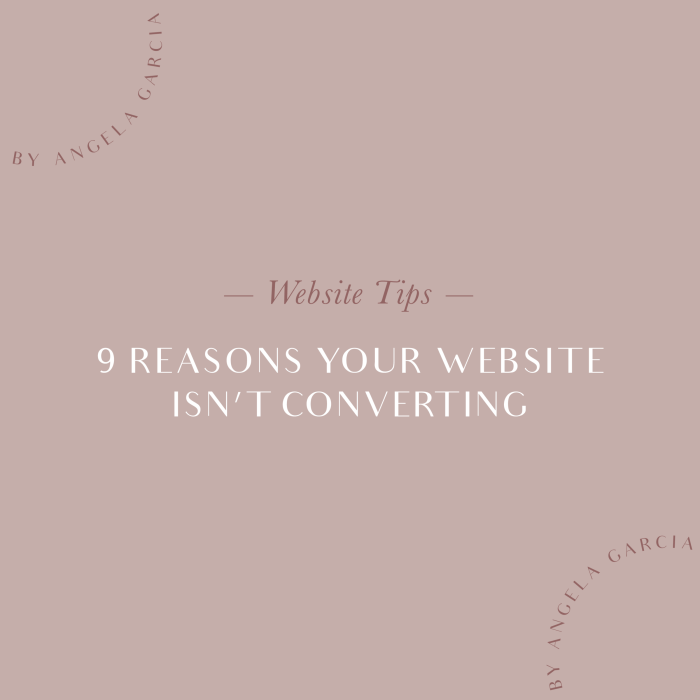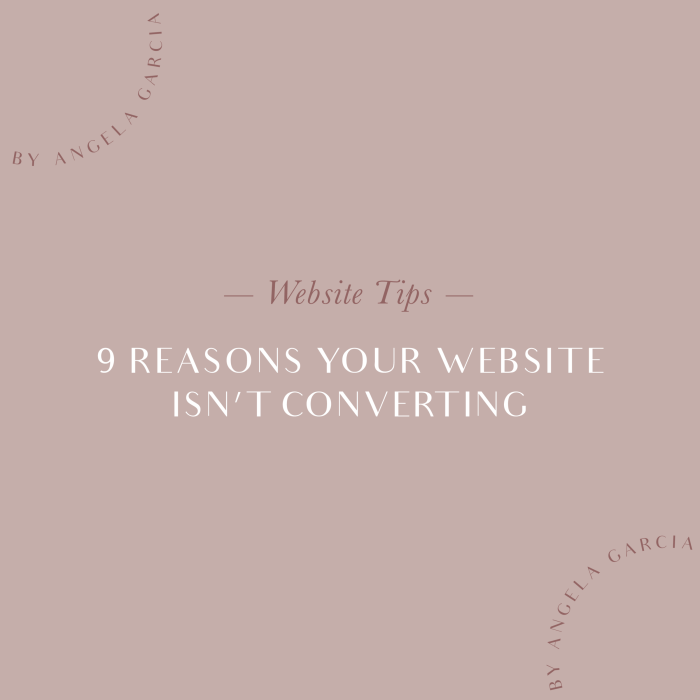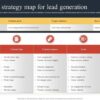My website doesnt convert – My website doesn’t convert, and I’m determined to figure out why. This isn’t just a simple fix; it’s a deep dive into various aspects of website design, content, and user experience. From the structure of my pages to the effectiveness of my marketing, we’ll explore potential problems and uncover actionable solutions to drive more conversions.
This comprehensive guide examines seven key areas, ranging from website design and content strategy to user experience, marketing, and technical optimization. We’ll delve into the critical role of target audience research and analytics, ultimately aiming to pinpoint the specific factors hindering your conversions. Let’s get started.
Website Design & Structure
A website’s design and structure are critical for driving conversions. A poorly designed site can lead to high bounce rates, lost opportunities, and ultimately, a failure to achieve desired results. Effective design, on the other hand, guides users through a clear path to conversion, ensuring a positive user experience and maximizing the return on investment.A well-structured website isn’t just aesthetically pleasing; it’s strategically planned to meet the needs of visitors and encourage desired actions.
This includes intuitive navigation, compelling calls to action, and a design that resonates with the target audience. Understanding the common pitfalls and implementing best practices in design can significantly improve conversion rates.
Common Website Design Flaws That Hinder Conversion
Poorly designed websites can frustrate visitors and deter them from completing desired actions. Common flaws include cluttered layouts, slow loading times, confusing navigation, and irrelevant content. In essence, a website that is not user-friendly will not convert. A user-centric approach is key to success.
- Cluttered Layouts: Overwhelming visitors with excessive visual elements, too many fonts, or inconsistent color palettes can create a disorienting experience, reducing engagement and potentially leading to high bounce rates. Visual clarity and a well-organized layout are crucial for effective user engagement.
- Slow Loading Times: Users expect websites to load quickly. Slow loading times can lead to frustration and abandonment, negatively impacting the conversion rate. Optimize images, use efficient code, and leverage caching strategies to ensure quick loading.
- Confusing Navigation: A website with illogical navigation structure can leave visitors feeling lost and confused. A clear and logical sitemap with easy-to-understand menus is essential to guide visitors towards their desired destination. Think about the user journey and map the steps to conversion.
- Irrelevant Content: Content that doesn’t align with user needs or expectations will fail to engage visitors. Ensure your content is tailored to your target audience, addressing their specific pain points and offering valuable solutions.
Importance of Clear Call-to-Actions (CTAs) and Their Placement
Effective calls to action are crucial for guiding visitors towards desired actions, such as making a purchase, signing up for a newsletter, or contacting a business. Clear and compelling CTAs, strategically placed throughout the website, significantly increase conversion rates.
My website just isn’t converting, and I’ve been scratching my head trying to figure out why. It’s frustrating, isn’t it? But I’ve discovered that the key to unlocking website success might just be focusing on the one thing that truly matters: understanding your target audience and crafting engaging content. This often boils down to the fundamental principle of “the only marketing strategy you need” the only marketing strategy you need , which I’m now implementing, and hopefully this will help me get my website back on track.
I’m hopeful this will finally solve the mystery of why my website doesn’t convert.
- Placement Strategy: CTAs should be strategically placed on the page, ensuring they are visible and easily accessible. For instance, placing a CTA button prominently above the fold can increase click-through rates.
- Clear and Compelling Language: CTAs should use clear, concise, and action-oriented language. Use language that speaks directly to the user’s needs and motivations.
- Visual Prominence: Use contrasting colors and font styles to make CTAs stand out visually. High visibility draws the eye to the call to action, increasing engagement and the potential for conversion.
How Website Navigation Impacts User Experience and Conversion Rates
A well-structured website navigation system plays a critical role in enhancing user experience and driving conversions. An intuitive and logical navigation system allows users to easily find the information they need, leading to increased engagement and conversions.
- Logical Hierarchy: A clear hierarchy of navigation helps visitors quickly find specific pages or sections. This hierarchy is crucial for a positive user experience.
- User-Friendly Menu Structure: Use a menu structure that is intuitive and easy to understand. Avoid overly complex or confusing menus. Employ a consistent design throughout the website to enhance user experience.
- Mobile Responsiveness: Ensure the website is optimized for mobile devices. Mobile responsiveness is essential in today’s world, as a significant portion of website traffic originates from mobile devices.
Examples of Well-Structured Websites That Excel in Conversion
Many websites demonstrate successful strategies for driving conversions through well-designed structures. For instance, Amazon’s clear navigation, intuitive product categorization, and compelling product pages create a seamless user experience. Similarly, successful websites prioritize user-friendliness and intuitive design elements to encourage conversion.
Website Layout Comparison
| Layout Type | Description | Potential Impact on Conversions |
|---|---|---|
| Single-Page Website | A website that presents all content on one page. | Can improve user experience by reducing navigation complexity, but may not be suitable for large amounts of content. |
| Multi-Page Website | A website with multiple pages for different sections of content. | Provides a more structured approach for presenting detailed information, and allows for better search engine optimization, potentially leading to higher conversion rates. |
| Landing Page | A dedicated page designed to drive a specific action from the user. | Highly effective for focusing the user’s attention on a single goal. |
Content Strategy & Messaging: My Website Doesnt Convert
Compelling website copy isn’t just about pretty words; it’s the driving force behind conversions. Effective content strategy translates your brand’s message into a user-friendly experience, encouraging visitors to take action. This section delves into the vital role of content in achieving website goals.A strong content strategy goes beyond simply filling pages with text. It’s about understanding your target audience, crafting a message that resonates with them, and providing value that encourages engagement and ultimately, conversions.
This requires a deep understanding of your ideal customer and tailoring the language and tone to speak directly to their needs and desires.
Significance of Compelling Website Copy for Conversions
Website copy plays a crucial role in influencing user behavior. Clear, concise, and engaging language builds trust, clarifies value propositions, and encourages visitors to move through the sales funnel. When copy effectively communicates the benefits of your products or services, it fosters a sense of connection with your brand, driving conversions and ultimately boosting revenue. For example, a compelling product description that highlights key features and benefits will encourage a customer to purchase, while a confusing or poorly written description will deter them.
Strategies for Creating Content that Resonates with the Target Audience
Understanding your target audience is paramount. Research and analysis should be conducted to identify their needs, pain points, and preferences. Tailoring content to speak directly to these specific needs builds trust and demonstrates that you understand and value their concerns. This can be achieved through surveys, focus groups, and analyzing existing customer data. For instance, if your target audience is environmentally conscious, your content should reflect this by emphasizing sustainable practices.
Importance of Providing Value Through Content
Content should aim to educate, inform, and entertain the target audience. Providing valuable information establishes your brand as a trustworthy authority in the field. This can be achieved by creating blog posts, articles, and other resources that provide solutions to common problems or answer frequently asked questions. Offering insightful articles or tutorials that position you as an expert in your industry builds trust and credibility, attracting potential customers and encouraging conversions.
For example, if you sell software, creating how-to videos or tutorials on using the software can demonstrate its value and attract customers seeking such solutions.
Structure for Organizing Website Content Based on the User Journey
A user’s journey through your website is crucial for understanding their needs and desires. Content should be structured to guide them seamlessly from initial awareness to purchase. This involves a phased approach. The first phase, awareness, should focus on attracting potential customers with engaging and informative content. The next phase, consideration, should provide in-depth information and comparison.
Finally, the conversion phase should present clear calls to action and simplify the purchase process.
Table Outlining Different Types of Website Content and Their Impact on Conversion
| Content Type | Description | Impact on Conversion |
|---|---|---|
| Blog Posts | Informative articles that engage readers and position your brand as an expert. | Builds trust, establishes authority, drives organic traffic, and generates leads. |
| Articles | In-depth pieces that explore specific topics and provide valuable information. | Deepens engagement, provides valuable resources, positions the brand as an authority, and fosters trust. |
| Product Descriptions | Detailed explanations of products or services, highlighting features and benefits. | Clearly communicates value, encourages purchase decisions, and addresses customer queries. |
| Case Studies | Real-world examples demonstrating the effectiveness of your products or services. | Builds credibility, showcases tangible results, and encourages potential customers to trust your offerings. |
| Testimonials | Customer reviews and feedback, providing social proof. | Inspires confidence and trust, encourages purchases based on positive experiences. |
User Experience (UX) & Usability
User experience (UX) is paramount to a successful website. A positive UX fosters engagement, encourages conversions, and ultimately drives business growth. Usability, a critical component of UX, focuses on how easily users can interact with your website to achieve their goals. This section delves into key UX aspects, examining how factors like loading times, mobile-friendliness, navigation, accessibility, and analytics impact user behavior and conversion rates.A well-designed website that prioritizes user experience creates a positive feedback loop.
Users enjoy their experience, leading to repeat visits, recommendations, and ultimately, higher conversion rates. Conversely, poor UX can lead to frustration, abandonment, and lost opportunities.
Impact of Slow Loading Times on User Experience and Conversion
Slow loading times significantly detract from user experience. Users are increasingly impatient and expect websites to load quickly. Studies show that a delay of even a few seconds can significantly impact user engagement. Users abandon websites that take longer than a few seconds to load. This loss of potential customers results in lower conversion rates.
For instance, a study by Google found that a one-second delay in page load time can lead to a 7% reduction in conversions. Optimizing images, using a Content Delivery Network (CDN), and minimizing HTTP requests are essential steps to reduce loading times and enhance the user experience.
How Mobile-Friendliness Affects User Experience and Conversion
Mobile-friendliness is no longer an option but a necessity. A significant portion of website traffic originates from mobile devices. A mobile-unfriendly website results in a poor user experience, driving users away. Users will struggle to navigate, read content, and complete tasks on a site not optimized for mobile. Consequently, mobile-unfriendly websites experience lower conversion rates.
Consider a user attempting to make a purchase on a site that is difficult to navigate on their phone. This frustration will likely result in the user abandoning the purchase process. Responsive design, which adapts to various screen sizes, is crucial for a positive mobile user experience.
Methods for Improving Website Navigation and Reducing Bounce Rates
Intuitive navigation is critical for guiding users towards their desired outcomes. A well-structured website with clear navigation helps users quickly find what they are looking for. Poor navigation leads to increased bounce rates, where users leave the site without engaging with the content. Implement a logical sitemap, use descriptive links, and employ clear calls-to-action (CTAs). A clear and concise menu structure, along with internal links, aids users in navigating the website.
Consider the user journey and create pathways that are simple and straightforward. A well-structured website with logical pathways helps users quickly locate the information they seek.
How Website Accessibility Affects Conversion
Website accessibility is a crucial aspect of UX. Ensuring your website is accessible to users with disabilities not only fulfills legal requirements but also broadens your potential customer base. Accessible websites use techniques like alt text for images, keyboard navigation, and proper color contrast. By implementing accessibility features, you enhance the user experience for all visitors. Users with disabilities often rely on screen readers, and the absence of proper alt text for images can create a poor user experience for these users.
How to Use Analytics to Identify User Behavior Patterns and Areas for Improvement
Website analytics provide invaluable insights into user behavior. Analyzing website data, such as bounce rates, time on page, and click-through rates, can reveal patterns and areas needing improvement. For instance, a high bounce rate from a specific page might indicate that the content is unclear or the call-to-action is ineffective. Utilize analytics platforms to monitor key metrics, track user journeys, and identify areas where improvements can be made.
Tools like Google Analytics offer detailed reports, allowing for in-depth analysis of user behavior. Understanding how users interact with your website is vital for improving UX and conversion rates.
Marketing & Promotion
A well-designed website is only half the battle. Effective marketing and promotion are crucial for driving traffic, generating leads, and ultimately, boosting conversions. A strategic approach to these activities is vital for maximizing the return on investment from your online presence. This section delves into the interconnectedness of marketing campaigns and website conversions, and explores key strategies for maximizing your online visibility.Marketing campaigns directly influence website conversions by driving targeted traffic to specific pages.
Successful campaigns not only attract visitors but also nurture them towards desired actions, such as making a purchase or filling out a contact form. Understanding the interplay between marketing and conversions allows for better allocation of resources and a more refined approach to online engagement.
Relationship Between Marketing Campaigns and Website Conversions
Marketing campaigns act as the bridge between your website and potential customers. By strategically targeting specific demographics and interests, campaigns can effectively guide users towards desired actions on your site. The success of these campaigns directly correlates with the website’s ability to deliver a positive user experience, ensuring that the traffic generated translates into conversions. This includes factors like fast loading times, easy navigation, and clear calls to action.
My website just isn’t converting as well as I’d hoped. I’ve been trying everything, from tweaking the design to optimizing the copy, but nothing seems to be working. Perhaps I need to consider the new features in Twitter’s campaign planner, like the expansion to more countries twitter expands campaign planner to more countries. Maybe I’m overlooking some crucial element in my marketing strategy.
Regardless, I need to find a solution quickly to get more traffic and sales!
Effective Marketing Strategies for Driving Traffic
A range of effective strategies can be implemented to drive traffic to your website. These strategies encompass various channels and techniques to reach a wider audience. Paid advertising, such as search engine ads and social media campaigns, can quickly drive targeted traffic to specific landing pages. Content marketing, through blog posts, articles, and infographics, attracts organic traffic through search engine optimization.
Email marketing, when done correctly, can nurture leads and maintain engagement with existing customers.
- Paid Advertising: Platforms like Google Ads and social media ads allow you to target specific demographics and interests. This can rapidly generate significant traffic to your website, especially when the ads are well-targeted and use persuasive language to entice potential customers.
- Content Marketing: Creating valuable and informative content, like blog posts, articles, and videos, improves search engine rankings and attracts organic traffic. High-quality content establishes your brand as an authority in your industry, leading to trust and increased conversions.
- Email Marketing: Email campaigns can nurture leads, build relationships, and maintain engagement with existing customers. By sending targeted messages, you can promote new products, offer exclusive discounts, and encourage repeat purchases. A well-structured email list and personalized content are key elements.
Impact of Social Media Promotion on Website Conversions
Social media platforms provide powerful tools for promoting your website and increasing conversions. By engaging with potential customers on these platforms, you can build brand awareness, drive traffic, and generate leads. Social media marketing should be viewed as an integral part of your overall marketing strategy. A consistent presence and engaging content are vital for maximizing the impact of social media on conversions.
- Brand Awareness: Consistent posting and engaging content build brand awareness and recognition, making your brand more easily identifiable and trustworthy.
- Traffic Generation: Social media posts can include links to your website, directly driving traffic to specific landing pages. This allows for targeted promotion of products, services, or special offers.
- Lead Generation: Running contests, giveaways, or asking questions can generate leads, allowing you to build an email list and further nurture potential customers.
Improving Search Engine Optimization () for Better Visibility
Search Engine Optimization () is essential for improving your website’s visibility in search engine results pages (SERPs). Optimizing your website for relevant s, using descriptive meta descriptions, and building high-quality backlinks are crucial steps. is a long-term strategy, but its effects can significantly impact your website’s organic traffic and conversions.
- Optimization: Researching and incorporating relevant s into your website’s content helps search engines understand the topic of your pages, improving their ranking in search results.
- Meta Descriptions: Crafting compelling meta descriptions for your web pages encourages users to click on your listings in search results.
- Backlink Building: Acquiring high-quality backlinks from reputable websites increases your website’s authority in the eyes of search engines, leading to better rankings.
Marketing Channels and Their Effectiveness
The effectiveness of various marketing channels in driving website conversions can differ depending on your target audience and industry. Here’s a table illustrating some common channels and their potential impact.
| Marketing Channel | Effectiveness in Driving Website Conversions |
|---|---|
| Search Engine Marketing (SEM) | High potential for targeted traffic, but requires budget allocation. |
| Social Media Marketing | High potential for brand awareness and lead generation, especially with targeted campaigns. |
| Content Marketing | High potential for organic traffic and long-term lead generation. |
| Email Marketing | High potential for nurturing leads and driving conversions from existing customers. |
| Paid Advertising (PPC) | High potential for quick traffic generation, but requires a budget and careful targeting. |
Conversion Tracking & Analytics
Understanding your website’s conversion rates is crucial for optimizing your online presence and achieving business goals. Conversion tracking and analytics provide invaluable insights into user behavior, identifying areas where improvements can be made and ultimately boosting your return on investment. A deep dive into these metrics reveals not just what’s working but also pinpoints the friction points that are preventing users from completing desired actions.Conversion tracking is more than just counting clicks; it’s about understanding the entire journey a user takes to become a customer.
By meticulously monitoring this journey, you can pinpoint the moments where users drop off, identify pain points, and implement strategies to enhance the user experience and increase conversions.
Importance of Tracking Website Conversions
Conversion tracking is vital for understanding user behavior and identifying areas requiring improvement. Without tracking, businesses lack a critical view into how users interact with their websites and what drives them to convert. This leads to a lack of data-driven decision-making and missed opportunities to optimize the website for better performance.
Using Analytics Tools to Identify Conversion Bottlenecks, My website doesnt convert
Numerous analytics tools provide insights into user behavior. Google Analytics, for example, allows detailed tracking of user interactions, from page views to conversions. These tools provide a wealth of data that can be analyzed to pinpoint bottlenecks in the conversion funnel. Identifying where users abandon the process (e.g., at a particular form submission step or after a product page view) is key to understanding what needs improvement.
A common issue, for instance, is a complicated checkout process.
Metrics for Evaluating Website Performance and Conversions
Various metrics provide insights into website performance and conversions. These metrics include but are not limited to:
- Conversion Rate: The percentage of visitors who complete a desired action (e.g., making a purchase, filling out a form). A low conversion rate suggests potential issues in the user journey.
- Bounce Rate: The percentage of visitors who leave the website after viewing only one page. A high bounce rate could indicate that the landing page isn’t engaging or relevant to the visitor’s needs.
- Average Session Duration: The average time spent by a visitor on your website. A short average session duration could suggest that the content isn’t compelling enough or that the website navigation is confusing.
- Pages per Session: The average number of pages a visitor views during a session. This metric provides insight into user engagement and the effectiveness of internal linking.
Analyzing Data to Pinpoint Specific Areas for Improvement
Analyzing the collected data allows for the identification of specific areas needing improvement. For example, if the bounce rate is high on a specific landing page, it suggests that the page content or design might not be effectively engaging users. By using data visualization tools, you can create visual representations of user behavior, highlighting trends and patterns that pinpoint specific issues.
My website just isn’t converting, and I’ve been scratching my head trying to figure out why. One potential solution I’m exploring is using Amazon’s retail ad service, which could really help drive traffic to my site. Amazon retail ad service might be a game-changer for my sales strategy, but I’m still not sure if it’s the perfect fit for my specific needs.
I’m going to have to do some more research and testing to see if it’s the right move for boosting conversions on my website.
Creating a Conversion Funnel Analysis
A structured approach to analyzing conversion funnels is crucial. This structured process involves the following steps:
- Define Goals: Clearly define the desired actions you want users to take (e.g., making a purchase, subscribing to a newsletter). This is the starting point of the analysis.
- Identify Key Stages: Break down the user journey into distinct stages, from initial landing to conversion. Each stage represents a step towards the desired action.
- Track Data: Utilize analytics tools to meticulously track user behavior at each stage of the funnel. Data points like click-through rates, time spent on each page, and drop-off rates are crucial.
- Analyze Metrics: Examine the collected data to identify trends and patterns. High drop-off rates at specific stages signal potential bottlenecks that need to be addressed.
- Identify Bottlenecks: Based on the analysis, pinpoint the specific points in the funnel where users are dropping off. A well-structured funnel analysis provides a clear roadmap for improvement.
- Implement Improvements: Based on the identified bottlenecks, implement changes to improve the user experience. This could include refining the landing page, optimizing the checkout process, or improving the overall website design.
Technical Issues & Optimization

A website’s technical underpinnings are crucial for conversion. Poorly optimized code, slow loading times, and security vulnerabilities can significantly hinder user experience and ultimately prevent conversions. Addressing these technical aspects is essential for a successful online presence.Understanding and proactively resolving technical issues is key to achieving high conversion rates. This includes optimizing website speed, ensuring security measures are in place, and promptly identifying and fixing any errors that might arise.
By prioritizing technical excellence, you create a smooth, secure, and engaging experience that encourages visitors to convert.
Potential Technical Issues Preventing Conversions
Technical glitches can manifest in various forms, impacting the user experience and conversion rates. Issues range from simple display problems to more complex server-side errors. These issues can discourage users and lead them to abandon their intended actions, ultimately hindering the desired conversions. For example, a site that frequently crashes or displays broken elements can damage its credibility.
Troubleshooting Common Website Errors
Effective troubleshooting involves systematic checks to identify and resolve issues quickly. First, thoroughly examine the website’s code and identify any syntax errors or logical inconsistencies. Next, carefully review the server logs for any error messages or unusual activity. Thorough examination of error logs is critical in understanding the nature of problems and their possible causes. If the issue persists, consider contacting the hosting provider or web developer for assistance.
Optimizing Website Speed for Better Performance
Website speed is a critical factor in user experience and conversion rates. A slow-loading website can lead to high bounce rates, as users lose patience and abandon the site. Optimization techniques can dramatically improve website speed. Compressing images, minifying code, and using a Content Delivery Network (CDN) are crucial steps in achieving optimal performance. For example, reducing the size of images without compromising quality through appropriate compression significantly speeds up page loading times.
Common Security Vulnerabilities Affecting Conversion Rates
Security vulnerabilities can compromise user data and trust, directly impacting conversion rates. Malicious attacks or inadequate security measures can result in data breaches, leading to loss of customer trust and potential legal repercussions. Regular security audits and updates are essential to mitigate these risks. Common vulnerabilities include outdated software, weak passwords, and vulnerabilities in the website’s code.
Implementing robust security protocols, including regular software updates and strong password policies, is crucial for safeguarding user data and protecting against cyber threats.
Potential Technical Problems and Solutions
| Potential Technical Problem | Possible Solution |
|---|---|
| Slow loading speed | Optimize images, use a CDN, and minimize HTTP requests. |
| Broken links | Regularly check and fix broken links using website crawlers or automated tools. |
| Inconsistent design | Ensure a consistent design across all pages using a style guide. |
| Security vulnerabilities | Regular security audits, updates, and strong passwords. |
| Display issues | Validate HTML, CSS, and JavaScript code for correctness. |
Target Audience & Market Research

Understanding your target audience is crucial for any successful online business. A well-defined target audience allows you to tailor your website’s content, design, and marketing strategies to resonate with the specific needs and desires of your ideal customers. This, in turn, leads to higher conversion rates and a more profitable business.Thorough market research provides invaluable insights into your target audience, enabling you to create a compelling online experience that encourages conversions.
By identifying their pain points and preferences, you can craft a website that addresses their needs effectively. This proactive approach translates into a stronger connection with potential customers and a more effective sales funnel.
Importance of Understanding the Target Audience
Understanding your target audience is essential for conversion optimization. A well-defined profile allows you to tailor website messaging, product offerings, and marketing campaigns to their specific needs and desires. This personalized approach fosters trust and strengthens the relationship between your brand and your customers.
Methods for Conducting Thorough Market Research
Several methods can be employed to gather comprehensive insights about your target audience. These include surveys, focus groups, interviews, and competitor analysis.
- Surveys: Surveys can collect quantitative data on customer preferences, needs, and pain points. A well-designed survey with clear questions can yield significant insights into your target market’s characteristics and behaviors.
- Focus Groups: Focus groups provide qualitative data by allowing you to observe and interact with potential customers in a structured environment. This approach helps to uncover deeper motivations and reasons behind customer choices.
- Interviews: One-on-one interviews offer a deeper understanding of individual customer needs and pain points. These interactions can uncover nuances and context that surveys might miss.
- Competitor Analysis: Analyzing your competitors’ websites, marketing strategies, and target audience allows you to identify opportunities and weaknesses in your own approach. This comparative study provides valuable insights for tailoring your strategy.
Identifying and Analyzing Customer Needs and Pain Points
Understanding customer needs and pain points is key to creating a website that effectively addresses their concerns. By identifying their problems, you can position your products or services as the solution.
- Identifying Pain Points: Pain points are the frustrations and problems customers face related to a specific product or service. By actively listening to customer feedback, you can identify the areas where your products or services fall short or fail to meet customer expectations.
- Analyzing Customer Needs: Customer needs represent the desires and requirements that customers seek to fulfill. Understanding these needs allows you to position your offerings as a solution to their problems and desires. A thorough analysis should involve understanding both the functional and emotional needs.
Tailoring Website Content to Specific Demographics
Tailoring website content to different demographics is vital for broader appeal and conversion. By understanding and adapting to various age groups, cultural backgrounds, and socioeconomic statuses, you can create a more inclusive and engaging website experience.
The Need for A/B Testing
A/B testing is a crucial method for optimizing website elements to improve conversion rates. By testing different versions of website elements, you can determine which variations are most effective in driving conversions.
- A/B Testing Methodology: A/B testing involves comparing two versions of a website element (e.g., button design, headline, or call-to-action). By measuring which version performs better, you can identify the most effective approach for conversion.
- Identifying Conversion Elements: A/B testing helps pinpoint specific website elements that contribute most significantly to conversions. This targeted approach focuses on optimizing the most impactful aspects of your website to improve overall performance.
Ultimate Conclusion
In conclusion, my website’s lack of conversion is likely a multifaceted issue, requiring a holistic approach to address. Understanding and analyzing the various components of your website, from design to marketing, is crucial for identifying the root causes of low conversion rates. By applying the strategies and insights discussed here, you can refine your website’s performance and achieve significant improvement in your conversion rates.






